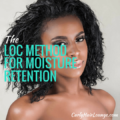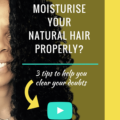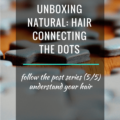One thing you learn very rapidly when transitioning to is that it is very important to keep your hair moisturised. Moisture (water) is everything, moisture is what is going to keep dryness as far away as possible from your hair. Dry hair can quickly transform into brittle hair or breakage and, consequently, the inability to retain length. Given that moisture can, and will eventually “escape” from your hair how do you keep it moisturised? Well, there is one technique vastly practised in the natural hair community that you can use to ensure moisture is kept inside. If you have problems controlling dryness then sealing your natural hair might be the perfect solution for you.
The Nature of Natural Hair & Sebum
Dry hair means thirsty hair, hair that is not properly moisturised. The inability of natural hair to retain moisture is closely, if not solely, connected to the shape of natural hair, which makes it difficult for sebum (hair’s natural oil) to travel along its length. The latter keeps hair conditioned and lubricated and creates an external barrier that keeps the hair protected. In the absence of sebum, our hair becomes dry.
This is definitely why so many transitioners, if not all, are such grade A students in the “Graduate School of Natural Hair”. We spend countless hours reading, watching and collecting photographic inspiration and information about natural hair. We want to avoid past mistakes and keep our hair as moisturised as possible.
We know that to keep hair moisturised we need water, oil and/or emollients (products that “marry” water with oil). While some can successfully do this without much difficulty others are not so lucky. Therefore, many resort to sealing their hair as this will mimic the function of sebum in the hair shaft – create a barrier (seal) to keep moisture inside.
What Is Sealing & What Does it Do To Natural Hair?
Sealing is the simple act of trapping the moisture in your hair when it’s simply wet or after you have applied a product that has as its first ingredient H2O (water). Sealing can be achieved by applying a serum or silicone based product or by using a vegetable oil (EVOO, coconut oil, argan oil, etc) or butter (shea butter, cocoa butter, etc).
A serum or silicone based product is a product that when applied on the hair creates a thin protective layer on the hair that protects it from sun, wind, heat styling tools damage and from moisture loss. However, if used improperly, its continued use creates product build up on the hair that stops it from getting any moisture. With time, this can create the exact same problem we were trying to avoid – dryness and breakage. But don’t freak out, read here how you can use silicones effectively.
To avoid product build-up you nee to remove it with the use of a clarifying shampoo, which is even more drying to the hair than regular shampoos as it removes all traces of sebum and leaves your hair even drier. The use of silicones has been vilified by many however, it does have its use and if you don’t overdo it, it can be an ally in giving your hair shine, fighting frizz and protection from heat. You just need to be aware of the damaging effects it can have and take preventive measures – use it sparingly and sparsely and clarify your hair at least once a month, more if you’re heavy handed on the serum or silicone.
On the other hand, using a vegetable oil or butter to seal your hair will be a healthier choice, one which I use myself. It will coat the hair, lock in the moisture and leave your hair soft and shiny. The advantage of using this option is that you are using a natural ingredient that will always work for your hair and never against. (You can guess which side I’m cheering for!) Additionally, vegetable oils are full of fatty acids that depending on their molecular weight, will penetrate the hair shaft and strengthen your hair. It’s a win-win situation here. The only disadvantage is that if you use too much your hair will look and feel greasy. So, a little goes a long way! Oh, let me also warn you that they can also cause build-up.
How Do You Seal Your Hair
The way in which you use your sealant of choice on your hair varies. In essence, you can apply a sealant straight after you have washed your hair. This will trap the water in and keep your hair hydrated. You can then follow with your styling products. However, as said before, to keep curly hair moisturised you need a combination of water, oils and emollients as moisturising it can be a difficult task. Therefore, the best way to accomplish this is to layer your products.
The order in which you apply these products, sealant included, varies according to personal preferences, although many will follow the L.O.C. (liquid, oil, creme) or the L.C.O (liquid, creme, oil) method to achieve maximum hydration and moisture for a longer period of time. This is why I’m a big supporter of the LOC method.
Do you seal your hair? What do you use to seal your hair? Have you noticed any improvements? Are you thinking about doing it?







12 thoughts on “What Is The Deal With Sealing Natural Hair?”
Great post on sealing natural hair. Will check back for future updates. Great job!
Thank you James! Don’t forget to share the word with your lady friends too. 🙂
This is a really great looking site with easy navigation! The layout is fluid and presentation is fantastic! There is a tom of information here! Great work, keep it up.
Hi Keith, thanks for your compliment specially coming from a guy in a site oriented towards women. But, hey hair is hair and much of what is written here also applies to you men. 🙂
I have used a product for sealing hair to keep the moisture for about 3 months now and I love what it does. My hair feels so much better. And I would imagine that it depends on how much product you use, but how often would you use the clarifying shampoo?
Hi Debra, sealing your hair leaves your hair softer and shinier.If you use a product with silicone in it, then i would recommend you to clarify your hair at least once a month, but always follow with a deep conditioning treatment. Clarifying depletes your hair of natural oils and deep conditioning it will balance this out. Have a good hair day and all the best to you! 🙂
I often feel my hair dry and life less. Will definitely try these ideas. Thank you for sharing these!
Your welcome Demi!
I use the LOC method on my low porosity med dense hair. I use African Shea butter to seal my hair and it keeps moisture in for days.
Make sure your shampooing and clarifying too, Misty!
Ive tried sealing with natural oils and butters but they don’t work for me. I’ll try a silicone based serum. I already use a clarifying shampoos cause my hair is prone to buildup.
Hi Aja. Yes, lost of people, like me in the past, use oils to seal moisture in their hair and silicones are also an option if you’re not trying to avoid them. Just make sure that if you’re using unsoluble silicones you remove them properly. 🙂